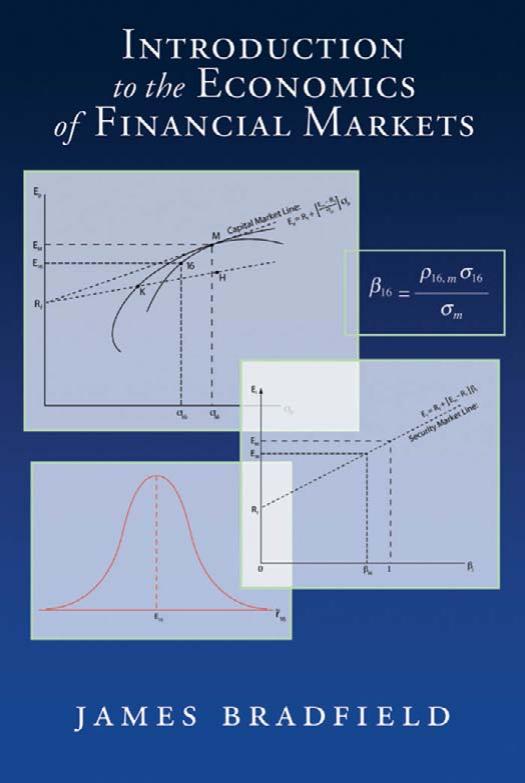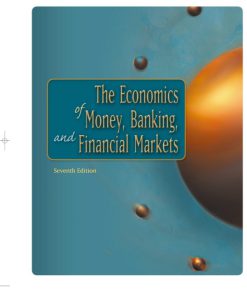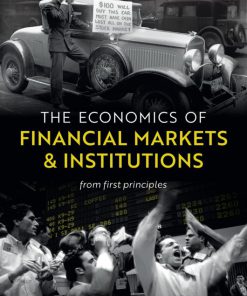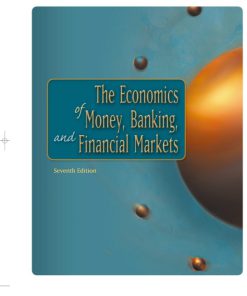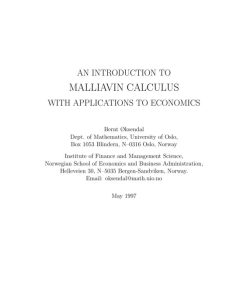Introduction to the economics of financial markets 1st Edition by James Bradfield 0195310632 9780195310634
$50.00 Original price was: $50.00.$25.00Current price is: $25.00.
Authors:Introduction to the economics of financial markets-Oxford University Press (2007) , Author sort:Press, Introduction to the economics of financial markets-Oxford University
Introduction to the economics of financial markets 1st Edition by James Bradfield – Ebook PDF Instant Download/Delivery. 0195310632, 9780195310634
Full download Introduction to the economics of financial markets 1st Edition after payment
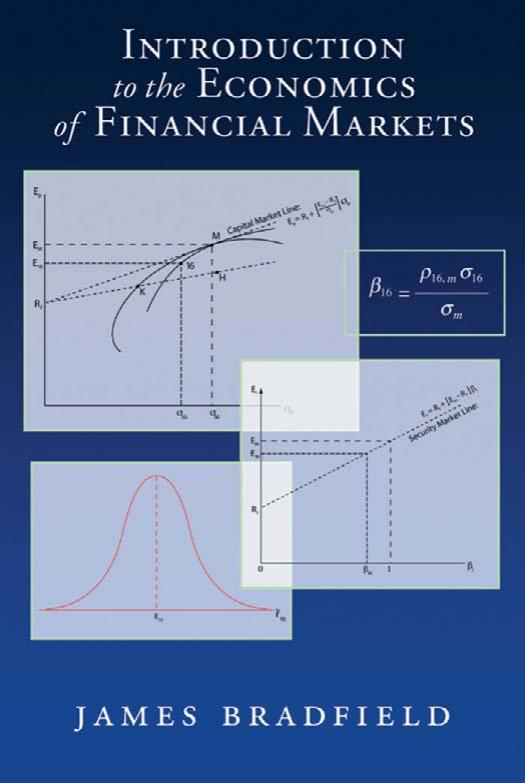
Product details:
ISBN 10: 0195310632
ISBN 13: 9780195310634
Author: James Bradfield
There are many textbooks for business students that provide a systematic, introductory development of the economics of financial markets. However, there are as yet no introductory textbooks aimed at more easily daunted undergraduate liberal arts students. Introduction to the Economics of Financial Markets fills this gap by providing an extremely accessible introductory exposition of how economists analyze both how, and how well, financial markets organize the intertemporal allocation of scarce resources. The central theme is that the function of a system of financial markets is to enable consumers, investors, and managers of firms to effect mutually beneficial intertemporal exchanges. James Bradfield uses the standard concept of economic efficiency (Pareto Optimality) to assess the efficacy of the financial markets. He presents an intuitive, and introductory, understanding of the primary theoretical and empirical models that economists use to analyze financial markets, and then uses these models to discuss implications for public policy. Students who use this text will acquire an understanding of the economics of financial markets that will enable them to read, with some sophistication, articles in the public press about financial markets and about public policy toward those markets. The book is addressed to undergraduate students in the liberal arts, but will also be useful for undergraduate and beginning graduate students in programs of business administration who want an understanding of how economists assess financial markets against the criteria of allocative and informational efficiency.
Introduction to the economics of financial markets 1st Table of contents:
Part I Introduction
1 The Economics of Financial Markets
1.1 The Economic Function of a Financial Market
1.2 The Intended Readers for This Book
1.3 Three Kinds of Trade-Offs
1.4 Mutually Beneficial Intertemporal Exchanges
1.5 Economic Efficiency and Mutually Beneficial Exchanges
1.6 Examples of Market Failures
1.7 Issues in Public Policy
1.8 The Plan of the Book
Problems
Notes
2 Financial Markets and Economic Efficiency
2.1 Financial Securities
2.2 Transaction Costs
2.3 Liquidity
2.4 The Problem of Asymmetric Information
2.5 The Problem of Agency
2.6 Financial Markets and Informational Efficiency
Problems
Notes
Part II Intertemporal Allocation by Consumers and Firms When Future Payments Are Certain
3 The Fundamental Economics of Intertemporal Allocation
3.1 The Plan of the Chapter
3.2 A Primitive Economy with No Trading
3.3 A Primitive Economy with Trading, but with No Markets
3.4 The Assumption That Future Payments Are Known with Certainty Today
3.5 Abstracting from Firms
3.6 The Distinction between Income and Wealth
3.7 Income, Wealth, and Present Values
Problems
Notes
4 The Fisher Diagram for Optimal Intertemporal Allocation
4.1 The Intertemporal Budget Line
4.2 Intertemporal Indifference Curves
4.3 Allocating Wealth to Maximize Intertemporal Utility
4.4 Mutually Beneficial Exchanges
4.5 The Efficient Level of Investment
4.6 The Importance of Informational Efficiency in the Prices of Financial Securities
Notes
5 Maximizing Lifetime Utility in a Firm with Many Shareholders
5.1 The Plan of the Chapter
5.2 A Firm with Many Shareholders
5.3 A Profitable Investment Project
5.4 Financing the New Project
5.5 Conclusion
Problems
Notes
6 A Transition to Models in Which Future Outcomes Are Uncertain
6.1 A Brief Review and the Plan of the Chapter
6.2 Risk and Risk Aversion
6.3 A Synopsis of Modern Portfolio Theory
6.4 A Model of a Firm Whose Future Earnings Are Uncertain: Two Adjacent Farms
6.5 Mutually Beneficial Exchanges: A Contractual Claim and a Residual Claim
6.6 The Equilibrium Prices of the Bond and the Stock
6.7 Conclusion
Problems
Notes
Part III Rates of Return as Random Variables
7 Probabilistic Models
7.1 The Objectives of Using Probabilistic Models
7.2 Rates of Return and Prices
7.3 Rates of Return as Random Variables
7.4 Normal Probability Distributions
7.5 A Joint Probability Distribution for Two Discrete Random Variables 142
7.6 A Summary Thus Far
7.7 The Effect of the Price of a Security on the Expected Value of Its Rate of Return
7.8 The Effect of the Price of a Security on the Standard Deviation of Its Rate of Return
7.9 A Linear Model of the Rate of Return
7.10 Regression Lines and Characteristic Lines
7.11 The Parameter ß as the Quantity of Risk in Security i
7.12 Correlation
7.13 Summary
Problems
Notes
Part IV Portfolio Theory and Capital Asset Pricing Theory
8 Portfolio Theory
8.1 Introduction
8.2 Portfolios as Synthetic Securities
8.3 Portfolios Containing Two Risky Securities
8.4 The Trade-Off between the Expected Value and the Standard Deviation of the Rate of Return on a Portfolio That Contains Two Securities
8.5 A Simple Numerical Example to Show the Effect of ρAB on the Trade-Off between Expected Return and Standard Deviation
8.6 The Special Cases of Perfect Positive and Perfect Negative Correlation
8.7 Trade-Offs between Expected Return and Standard Deviation for Portfolios That Contain N Risky Securities
8.8 Summary
Problems
Notes
9 The Capital Asset Pricing Model
9.1 Introduction
9.2 Capital Market Theory and Portfolio Theory
9.3 The Microeconomic Foundations of the CAPM
9.4 The Three Equations of the CAPM
9.5 A Summary of the Intuitive Introduction to the CAPM
9.6 The Derivation of the Capital Market Line
9.7 The Derivation of the Security Market Line
9.8 Interpreting ßi as the Marginal Effect of Security i on the Total Risk in the Investor’s Portfolio
9.9 Summary
Problem
Notes
10 Multifactor Models for Pricing Securities
10.1 Introduction
10.2 Analogies and an Important Distinction between the Capital Asset Pricing Model and Multifactor Models
10.3 A Hypothetical Two-Factor Asset Pricing Model
10.4 The Three-Factor Model of Fama and French
10.5 The Five-Factor Model of Fama and French
10.6 The Arbitrage Pricing Theory
10.7 Summary
Appendix: Estimating the Values of β and λ for a Two-Factor Model
Problem
Notes
Part V The Informational and Allocative Efficiency of Financial Markets: The Concepts
11 The Efficient Markets Hypothesis
11.1 Introduction
11.2 Informational Efficiency, Rationality, and the Joint Hypothesis
11.3 A Simple Example of Informational Efficiency
11.4 A Second Example of Informational Efficiency: Predictability of Returns—Bubbles or Rational Variations of Expected Returns?
11.5 Informational Efficiency and the Predictability of Returns
11.6 Informational Efficiency and the Speed of Adjustment of Prices to Public Information
11.7 Informational Efficiency and the Speed of Adjustment of Prices to Private Information
11.8 Information Trading, Liquidity Trading, and the Cost of Capital for a Firm
11.9 Distinguishing among Equilibrium, Stability, and Volatility
11.10 Conclusion
Appendix: The Effect of a Unit Tax in a Competitive Industry
Notes
12 Event Studies
12.1 Introduction
12.2 Risk-Adjusted Residuals and the Adjustment of Prices to New Information
12.3 The Structure of an Event Study
12.4 Examples of Event Studies
12.5 Example 1: The Effect of Antitrust Action against Microsoft
12.6 Example 2: Regulatory Rents in the Motor Carrier Industry
12.7 Example 3: Merger Announcements and Insider Trading
12.8 Example 4: Sudden Changes in Australian Native Property Rights 305
12.9 Example 5: Gradual Incorporation of Information about Proposed Reforms of Health Care into the Prices of Pharmaceutical Stocks
12.10 Conclusion
Notes
Part VI The Informational and Allocative Efficiency of Financial Markets: Applications
13 Capital Structure
13.1 Introduction
13.2 What Is Capital Structure?
13.3 The Economic Significance of a Firm’s Capital Structure
13.4 Capital Structure and Mutually Beneficial Exchanges between Investors Who Differ in Their Tolerances for Risk
13.5 A Problem of Agency: Enforcing Payouts of Free Cash Flows
13.6 A Problem of Agency: Reallocating Resources When Consumers’ Preferences Change
13.7 A Problem of Agency: Asset Substitution
13.8 Economic Inefficiencies Created by Asymmetric Information
13.9 The Effect of Capital Structure on the Equilibrium Values of Price and Quantity in a Duopoly
13.10 The Effect of Capital Structure on the Firm’s Reputation for the Quality of a Durable Product
13.11 Conclusion
Appendix
Problems
Notes
14 Insider Trading
14.1 Introduction
14.2 The Definition of Insider Trading
14.3 Who Owns Inside Information?
14.4 The Economic Effect of Insider Trading: A General Treatment
14.5 The Effect of Insider Trading on Mitigating Problems of Agency
14.6 The Effect of Insider Trading on Protecting the Value of a Firm’s Confidential Information
14.7 The Effect of Insider Trading on the Firm’s Cost of Capital through the Effect on Liquidity
14.8 The Effect of Insider Trading on the Trade-Off between Insiders and Informed Investors in Producing Informative Prices
14.9 Implications for the Regulation of Insider Trading
14.10 Summary
Notes
15 Options
15.1 Introduction
15.2 Call Options
15.3 Put Options
15.4 A Simple Model of the Equilibrium Price of a Call Option
15.5 The Black-Scholes Option Pricing Formula
15.6 The Put-Call Parity
15.7 Homemade Options
15.8 Introduction to Implicit Options
15.9 Implicit Options in a Leveraged Firm
15.10 An Implicit Option on a Postponable and Irreversible Investment Project
15.11 Summary
Appendix: Continuous Compounding
Problems
Notes
16 Futures Contracts
16.1 Introduction
16.2 Futures Contracts as Financial Securities
16.3 Futures Contracts and the Efficient Allocation of Risk
16.4 The Futures Price, the Spot Price, and the Future Price
16.5 The Long Side and the Short Side of a Futures Contract
16.6 Futures Contracts as Financial Securities
16.7 Futures Contracts as Transmitters of Information about the Future Values of Spot Prices
16.8 Investment, Speculation, and Hedging
16.9 Futures Prices as Predictors of Future Values of Spot Prices
16.10 Conclusion
Notes
17 Additional Topics in the Economics of Financial Markets
17.1 Bonds
17.2 Initial Public Offerings
17.3 Mutual Funds
17.4 Behavioral Finance
17.5 Market Microstructure
17.6 Financial Derivatives
17.7 Corporate Takeovers
17.8 Signaling with Dividends
17.9 Bibliographies
Note
18 Summary and Conclusion
18.1 An Overview
18.2 Efficiency
18.3 Asset Pricing Models
18.4 Market Imperfections
18.5 Derivatives
18.6 Implications for Public Policy
18.7 A Final Word
Notes
Answers to Problems
Glossary
Bibliography of Nobel Laureates
People also search for Introduction to the economics of financial markets 1st:
introduction financial economics
an introduction to financial markets
introduction to the stock market pdf
introduction to financial economics pdf
You may also like…
eBook PDF
An Introduction to Malliavin Calculus with Applications to Economics 1st Edition by Bernt Øksendal

